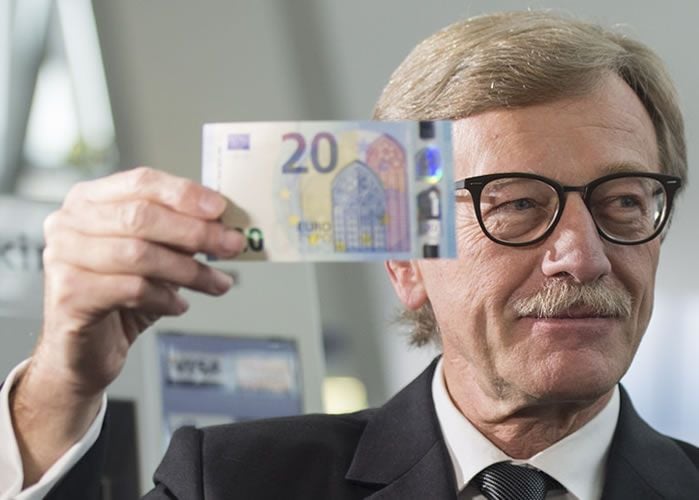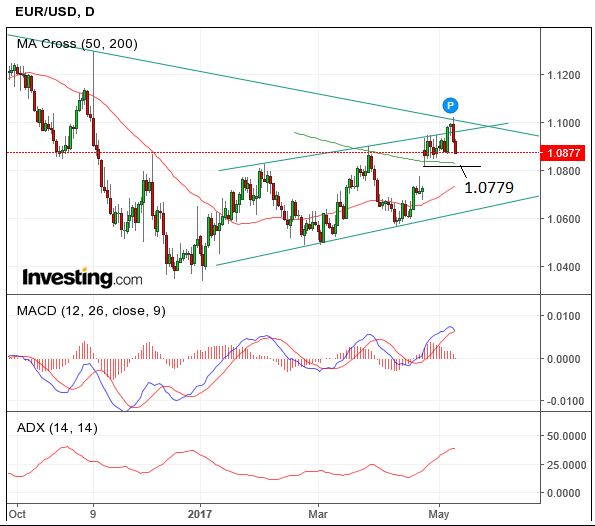Euro to US Dollar Poised for Period of Volatility

EUR/USD has presented investors with something of an enigma of late after acting in an arguably completely unexpected fashion following the French election.
The pair refused to rise after Macron’s victory, opting instead to fall.
Analysts said this was because the pair had already soaked up the risk of a Macron win after the first round, and, in their defence EUR/USD did gap up following the first round which he won outright.
But another reason the Euro fell after Macron’s win could be because of its inverse relationship to risk.
The Euro is inversely correlated to risk which means it rises during times of crisis and falls during times of confidence, so when Macron won and the world breathed a sigh of relief, the currency did what it always does - the opposite - it weakened.
The Euro still benefits from extremely low relative borrowing rates and is therefore used by investors to fund riskier investments abroad.
When risk aversion rises, however, those investors often pull out of these riskier investments and repatriate their Euro’s increasing the currency’s demand and helping it to appreciate. Likewise when risk appetite increases they tend to sell even more Euros to buy even
Likewise, when risk appetite increases they tend to sell even more Euros to buy even riskier assets, so as Macron entered the Elysee, the Euro was being used to fund riskier emerging market/international deals.
Today (Tuesday) the pair has extended its weakness still further, falling into the 1.0880s and is looking perilously close to filling the gap left after the first round of the French elections.
If it falls below the gap’s high at 1.0819 it would confirm a gap fill with a downside target at 1.0779.
The indicators on the daily chart seem to corroborate this view with MACD at a cycle high and looking like it is poised to roll over, and the ADX – which measures volatility – also now looking toppy.
There is a possibility, therefore, that we may see that pair fall temporarily to finally fill the gap.

Longer-term, however, the weekly chart shows promisingly bullish signs from the two indicators, with MACD having just pierced above the key zero-line which differentiates the trend and the ADX recovering robustly from historic lows of below 10.
The ADX, in particular, looks like it could very well continue rising.
This indicates an increase in volatility which chimes with what market analysts have been saying about the increasing probability volatility will rise after hitting extreme lows recently.
"With the event risk of Sunday’s French election passing with no surprise, the Euro fell on profit-taking against the US Dollar and Sterling. The Euro Stoxx 500 volatility index, VSTOXX also tumbled 15% yesterday to close at 14.39. That’s near the bottom of the YTD range with the low mark set back on March 17th at 11.16 (the average in 2017 so far has been 19.98). FX volatility meanwhile, as measured by the CVIX Index, hit the lowest level since October 2014," said Investec Dealing's 'Jon'.
In terms of which direction volatility will pick up in and on this score there seems to be a possibility it could favour USD.
"Policy risks seem underpriced. The market anticipates a slow US hiking cycle, but benign financial conditions could encourage the Fed to be more aggressive," said Deutsche Bank's Oliver Harvey in note purely on the subject of low volatility.
Most analysts are currently bullish the Euro now that the major risk event of the French election is out of the way, and markets can revert to focusing on monetary policy instead.
The European Central Bank (ECB) could now became the focus of attention as it is expected to have more amplitude to normalize policy.
“We think the dissolution of the French election risk will allow market participants to fully focus on the next key theme in FX markets – the ECB QE tapering – which should be EUR positive and lead to the first one-off discrete jump from the current 1.09 to the 1.15 level,” said ING’s Petr Krpata in a note to clients today.
Krpata sees this as the first of two jumps for the Euro, the second of which will occur in 2018 when the pair will rise again after the ECB starts raising the deposit rate.
The Euro is likely to become even more sensitive to interest rate expectations due to the increased correlation between the US Dollar and risk appetite.
Since the advent of Trump’s reflationary ideas, the Dollar has become more representative of global risk appetite trends and therefore tends to rise when risk appetite does.
This positions it in direct contrast to the Euro which is inversely correlated to risk trends as explained above.
This indicates the possibility of a period of increased volatility for the EUR/USD on the horizon and could explain why the moves down since Macron’s win were so volatile.
Until the ECB actually makes signs that it is going to taper QE and begin policy normalising, bringing Eurozone interest rates off the floor the Euro will remain susceptible to risk trends.
The Dollar, in contrast, looks increasingly likely to manifest through it expectations of global growth and therefore rise precisely when the Euro is falling because of the same drivers.
This is likely to continue until the ECB raise interest rates and the Euro stops being targeting as a top funding currency.
This fact could, therefore, cap gains unless the world enters a less benign scenario and risk trends turn sour.
The pair might rise, for example, if the Fed were to cancel its expected June rate hike, or if the ECB mentioned early tapering – otherwise it may stay depressed.
Save
Save
